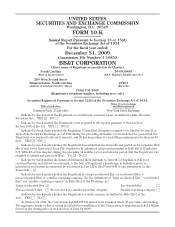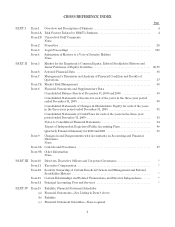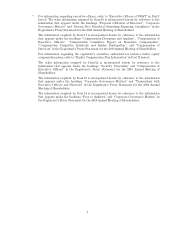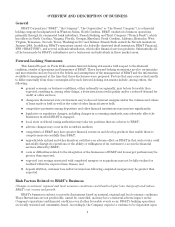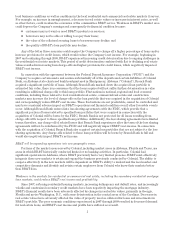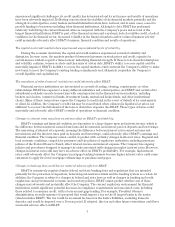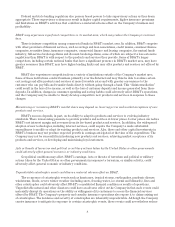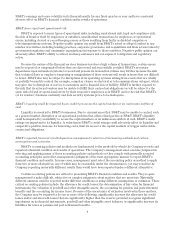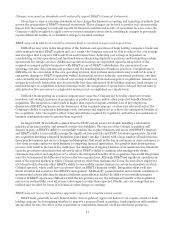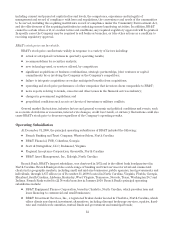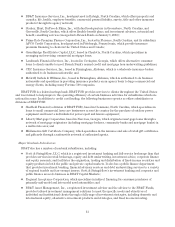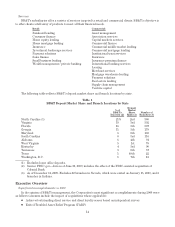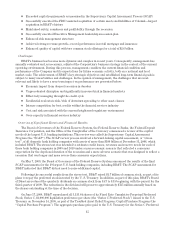BB&T 2009 Annual Report Download - page 8
Download and view the complete annual report
Please find page 8 of the 2009 BB&T annual report below. You can navigate through the pages in the report by either clicking on the pages listed below, or by using the keyword search tool below to find specific information within the annual report.Federal and state banking regulators also possess broad powers to take supervisory actions as they deem
appropriate. These supervisory actions may result in higher capital requirements, higher insurance premiums
and limitations on BB&T’s activities that could have a material adverse effect on the Company’s business and
profitability.
BB&T may experience significant competition in its market area, which may reduce the Company’s customer
base.
There is intense competition among commercial banks in BB&T’s market area. In addition, BB&T competes
with other providers of financial services, such as savings and loan associations, credit unions, consumer finance
companies, securities firms, insurance companies, commercial finance and leasing companies, the mutual funds
industry, full-service brokerage firms and discount brokerage firms, some of which are subject to less extensive
regulations than BB&T is with respect to the products and services they provide. Some of BB&T’s larger
competitors, including certain national banks that have a significant presence in BB&T’s market area, may have
greater resources than BB&T, may have higher lending limits and may offer products and services not offered by
BB&T.
BB&T also experiences competition from a variety of institutions outside of the Company’s market area.
Some of these institutions conduct business primarily over the Internet and may thus be able to realize certain
cost savings and offer products and services at more favorable rates and with greater convenience to the
customer who can pay bills and transfer funds directly without going through a bank. This “disintermediation”
could result in the loss of fee income, as well as the loss of customer deposits and income generated from those
deposits. In addition, changes in consumer spending and saving habits could adversely affect BB&T’s operations,
and the Company may be unable to timely develop competitive new products and services in response to these
changes.
Maintaining or increasing BB&T’s market share may depend on lowering prices and market acceptance of new
products and services.
BB&T’s success depends, in part, on its ability to adapt its products and services to evolving industry
standards. There is increasing pressure to provide products and services at lower prices. Lower prices can reduce
BB&T’s net interest margin and revenues from its fee-based products and services. In addition, the widespread
adoption of new technologies, including internet services, could require the Company to make substantial
expenditures to modify or adapt its existing products and services. Also, these and other capital investments in
BB&T’s business may not produce expected growth in earnings anticipated at the time of the expenditure. The
Company may not be successful in introducing new products and services, achieving market acceptance of its
products and services, or developing and maintaining loyal customers.
Acts or threats of terrorism and political or military actions taken by the United States or other governments
could adversely affect general economic or industry conditions.
Geopolitical conditions may affect BB&T’s earnings. Acts or threats of terrorism and political or military
actions taken by the United States or other governments in response to terrorism, or similar activity, could
adversely affect general economic or industry conditions.
Unpredictable catastrophic events could have a material adverse effect on BB&T.
The occurrence of catastrophic events such as hurricanes, tropical storms, earthquakes, pandemic disease,
windstorms, floods, severe winter weather (including snow, freezing water, ice storms and blizzards), fires and
other catastrophes could adversely affect BB&T’s consolidated financial condition or results of operations.
Unpredictable natural and other disasters could have an adverse effect on the Company in that such events could
materially disrupt its operations or the ability or willingness of its customers to access the financial services
offered by BB&T. The Company’s property and casualty insurance operations also expose it to claims arising out
of catastrophes. The incidence and severity of catastrophes are inherently unpredictable. Although the Company
carries insurance to mitigate its exposure to certain catastrophic events, these events could nevertheless reduce
8

